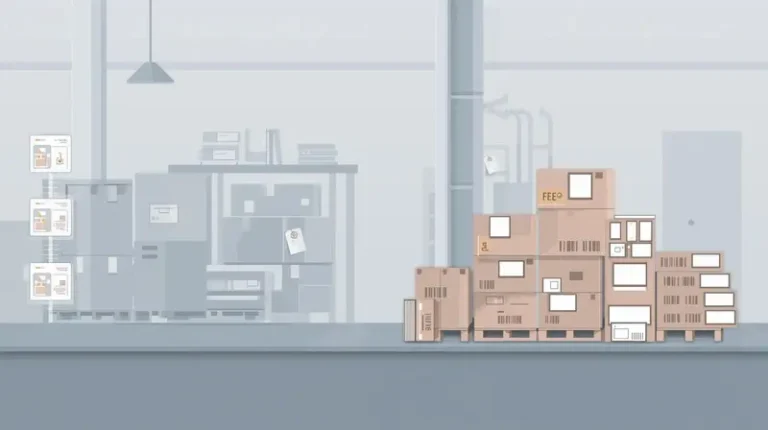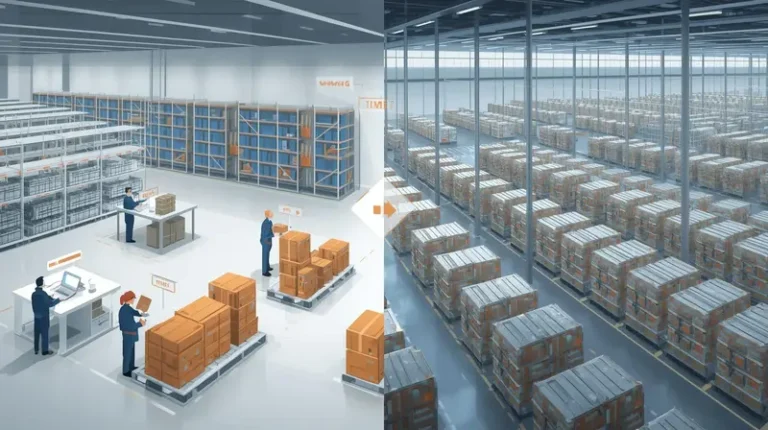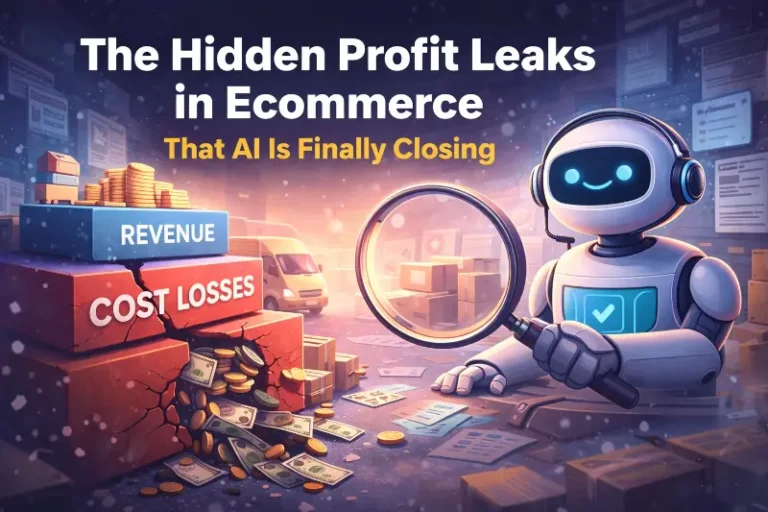Top 3 Alternatives to Amazon FBA

Last updated on July 29, 2025

What’s not to love about Amazon FBA? List your product on Amazon, send them your inventory, and reap the rewards of the Amazon Prime badge and low shipping costs (though FBA fees are rising again).
It can be a great deal for small and light products, but sellers need to be aware of rising FBA fees, and that it’s limited in two key ways: 1) it’s an inflexible point solution, and 2) Amazon frequently changes the rules, mostly to its benefit. Also, Red Stag Fulfillment reports that Amazon adds over 500 new 3rd-party sellers a day in 2025, so FBA often struggles to keep up with demand on both the receiving and fulfillment side of the logistics operation. Amazon’s response is to limit FBA to work well only for the SKUs that maximize its profit (not the sellers’) and to impose restrictive inventory limits.
Sellers that want to grow both in and outside of the Amazon marketplace will need an alternative to FBA to keep their growth engine humming. Read on to learn more about what to watch out for with Amazon FBA and your options for other ecommerce order fulfillment solutions.
Why You Can’t Rely on Just Amazon FBA
Amazon FBA will do a great job of fulfilling a portion of the volume of your small SKUs sold on Amazon, but it falls short otherwise.
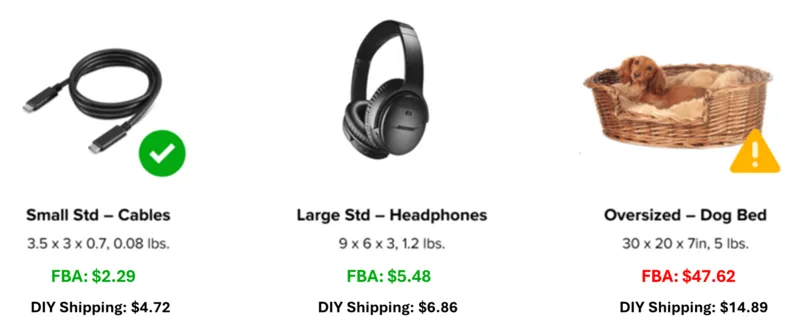
Source: Amazon FBA Revenue Calculator, DIY Shipping estimated using Cahoot discounted shipping rates for Zone 4 Residential addresses.
The above example is typical of Amazon FBA fees: their price for small and standard items beats other options, but even slightly oversized products like the example 5lb dog bed ends up costing more than triple the price that a merchant could ship on their own (or using outsourced fulfillment services). The reason is simple: they’ve optimized their network for small, easy, and efficient products.
As a result, Amazon sellers who use FBA for their shipping are boxed in when it comes to growth, and they all compete with one another to sell the same small, cheaper items. If FBA is your only good option, you can’t profitably expand your product line to larger, less competitive options because fulfillment fees will eat up your margins, making a 3PL a necessary consideration. If you raise the price to compensate, then you’ll lose to the savvy merchants who have diversified their fulfillment strategies and can get the product to the customer at one-third the price.
The challenges don’t end there for Amazon FBA. Ecommerce’s year-over-year unprecedented boom in growth through the pandemic has delivered massive returns to Amazon and Amazon sellers, but it’s also left FBA bursting at the seams. To compensate, Amazon switched from ASIN-level inventory limits to product-type inventory limits, and overnight sellers saw their inventory limits cut by up to 65%. To this day, Amazon still enforces restock limits based on broader storage types rather than individual SKUs (e.g., standard-size, oversized, apparel, footwear), applied at the account level rather than per-product. These remain the primary structure for restock limits in 2025.
However, recent trends indicate that Amazon has quietly reinstated some ASIN-level restock restrictions on top of storage-type limits, especially during periods of high demand or for seasonal products. These additional thresholds mean that even if your total storage capacity is sufficient, a specific ASIN may be capped based on the seller’s historical sales and forecasted demand. These mixed restrictions are reported to be in effect as of mid-2025.
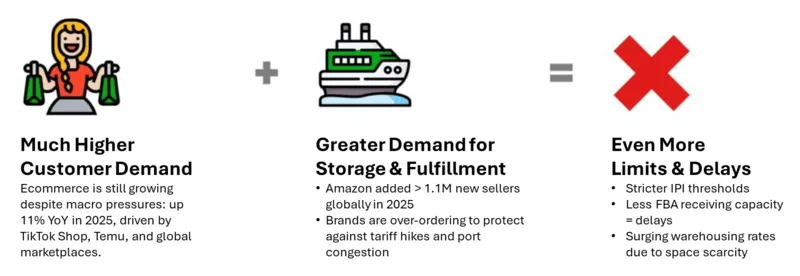
Source: US Census Bureau, Marketplace Pulse, Cahoot interviews with merchants
On top of the storage limitations, Amazon FBA can also take three or more weeks to receive inventory. This creates a huge window of time in which a seller can run out of stock on a key item, even if the seller sent a timely replenishment. And this assumes you chose the more complex and costly inbound plan and shipped all your inventory to regional Amazon FCs (rather than sending it all to one location and paying Amazon to distribute (place) the inventory for you). In the peak selling season, this is an even bigger problem. Demand surges can easily run an item out of stock in a matter of days or even hours, triggering a death spiral in which a product loses its search rank, which lowers impressions and conversions, which in turn lowers inventory limits again.
It’s clear that Amazon FBA is no longer an all-in-one solution for Amazon sellers. It’s a point solution that can be an important part of a fulfillment strategy, but needs to be augmented to cover for its flaws.
Slash Your Fulfillment Costs by Up to 30%
Cut shipping expenses by 30% and boost profit with Cahoot's AI-optimized fulfillment services and modern tech —no overheads and no humans required!
I'm Interested in Saving Time and MoneyEvaluating Amazon FBA Order Fulfillment Alternatives
Amazon FBA’s structure tells a valuable, if simple, lesson: the most cost-effective way to offer nationwide 1-day and 2-day delivery is to create a distributed fulfillment network that always has inventory near the end customer. This setup enables 1- and 2-day delivery with economic ground shipping, and without all the FBA restrictions and limitations; the best of both worlds.
To enjoy the same benefits of Amazon FBA’s network without the same drawbacks, sellers’ options generally fall into three main categories:
1. Open Multiple Fulfillment Centers Yourself
Some merchants consider opening their own network of fulfillment centers, but this path is rarely viable today. Commercial real estate costs remain high, and even when space is available, labor remains unpredictable and expensive. Recruiting, training, and retaining warehouse staff across multiple regions is a full-time operation in itself, often diverting attention from core business growth. Plus, the upfront capital outlay is steep, and long-term flexibility is limited. Consumer demand patterns shift quickly, and you’re locked in if a location becomes unprofitable or underutilized. Managing your own distributed network might seem like a way to “own” your fulfillment, but in practice, it often results in underperformance, overstaffing, and operational drag.
2. Third-Party Logistics Companies (3PLs)
Another option is to outsource fulfillment to multiple 3PLs. These are generally smaller, independent companies not connected to any specific marketplace, but can offer comprehensive supply chain solutions. But, you will have to contract with numerous 3PLs to get nationwide 1-day and 2-day coverage. Order routing across disparate 3PLs is complex and labor-intensive, so you may need to invest in expensive fulfillment software to make it more efficient. Fulfillment costs will vary between 3PLs, and not all of them can meet the strict SLAs needed to win the Buy Box on every marketplace, so be sure to use something like a 3PL request for proposal (RFP) template to get an apples-to-apples comparison.
3. Tech-enabled Fulfillment Network
A modern and affordable alternative to working with 3PLs is to use an ecommerce order fulfillment network. A tech-enabled fulfillment network upgrades the traditional 3PL model to cover the whole country in a single solution. Merchants send their inventory to multiple nodes in the network, and then the network’s software will automatically send parcels from the optimal location to the end customer, saving on shipping costs. In essence, these networks are “FBA-lite” – they have the same core functionality as FBA.
Definition of a Fulfillment Company
A fulfillment company is a third-party logistics (3PL) provider that specializes in managing the entire order fulfillment process for ecommerce businesses. They handle tasks such as inventory management, warehousing, order processing, packaging, and shipping. By outsourcing these logistics services, ecommerce businesses can focus on their core operations, such as marketing and product development, while the fulfillment company ensures that orders are processed efficiently and accurately.
Looking for a New 3PL? Start with this Free RFP Template
Cut weeks off your selection process. Avoid pitfalls. Get the only 3PL RFP checklist built for ecommerce brands, absolutely free.
Get My Free 3PL RFPBenefits of a Fulfillment Company in Ecommerce
A fulfillment company plays a crucial role in providing efficient and cost-effective order fulfillment services to sellers. Acting as an extension of the ecommerce business, these companies manage logistics and supply chain operations, ensuring that customers receive their orders quickly and accurately. This allows ecommerce businesses to scale their operations without the burden of managing warehousing, packing, and shipping, ultimately enhancing customer satisfaction and operational efficiency.
Cahoot: Alternative to Amazon FBA
Cahoot is a robust FBA alternative, and it works just as well as a backup or enhancement to FBA as it does as a full replacement. And Cahoot’s much more than that; it’s the most flexible solution in the marketplace and can ship orders for every ecommerce sales channel.
Cahoot is the next generation of tech-enabled fulfillment networks. Unlike other networks that are collections of 3PLs, Cahoot’s innovative approach unlocks and empowers merchants across the country to fulfill orders for one another. Our peer-to-peer network is a collective of highly vetted ecommerce retailers who offer up excess warehouse space and resources to provide high-quality order fulfillment to other merchants.
As a result, costs are lower than what you get with a traditional 3PL fulfillment company, and service levels are higher. For example, Dunn-Rite Products saves over $100,000 per year in shipping costs alone by shipping local orders from their Indiana and Colorado warehouses, and outsourcing fulfillment to Cahoot for regional distribution (California, Texas, Florida, Pennsylvania). They offer nationwide 1- and 2-day economical ground shipping across all their channels and dominate their category against brands that can’t compete using FBA alone.
So you can see: the Cahoot P2P network makes the Dunn-Rite example the norm for anyone selling items that don’t fit into the “small and light” box. Merchants can use the network solely for outsourced fulfillment, similar to FBA; they can partially outsource fulfillment while maintaining some of their own in-house fulfillment capacity (where it makes sense), and they can even choose to join the network as a fulfillment partner and fulfill orders for other merchants allowing them to offset some of their own outsourced fulfillment costs.
Frequently Asked Questions
What are the costs for FBA?
The main costs associated with Amazon FBA are fulfillment fees, storage fees (including aged inventory surcharges), and any extra charges for removal or disposal of inventory, inventory prep such as barcoding, placement fees, inbound defect fees, and possibly others. Make sure to factor these into your pricing strategy!
What is a 3PL?
A third-party logistics company (3PL) is a service provider that either arranges or handles a variety of supply chain functions for a business. These functions can include brokering, shipping, storing, or packing a company’s freight, as well as supply chain strategy and access to technology.
Is 3PL pricing more transparent?
3PL providers ensure transparent pricing by offering customizable logistics solutions and engaging in contract negotiations, which allows for clear and flexible pricing options. This way, you know exactly what you’re paying for and can budget accordingly.
How can I switch from Amazon FBA to a tech-enabled fulfillment network?
To switch from Amazon FBA to a tech-enabled fulfillment network, start by evaluating your current SKUs and sales channels. Choose a network like Cahoot that offers nationwide 1-day and 2-day delivery, integrates with your sales platforms, and provides a streamlined onboarding process. Make sure to assess storage capacity, order volume compatibility, and return logistics to ensure a smooth transition that doesn’t disrupt your fulfillment operations.
Do FBA alternatives offer better control over inventory and fulfillment costs?
Yes, most alternatives to Amazon FBA give merchants greater control over inventory distribution and fulfillment costs. Unlike FBA, which imposes inventory limits and seasonal surcharges, tech-enabled networks and independent 3PLs allow for dynamic inventory allocation and cost transparency. This flexibility helps sellers reduce storage costs, optimize shipping rates, and avoid stockouts, especially during peak seasons or marketplace fluctuations.

Turn Returns Into New Revenue


 10 minutes
10 minutes
